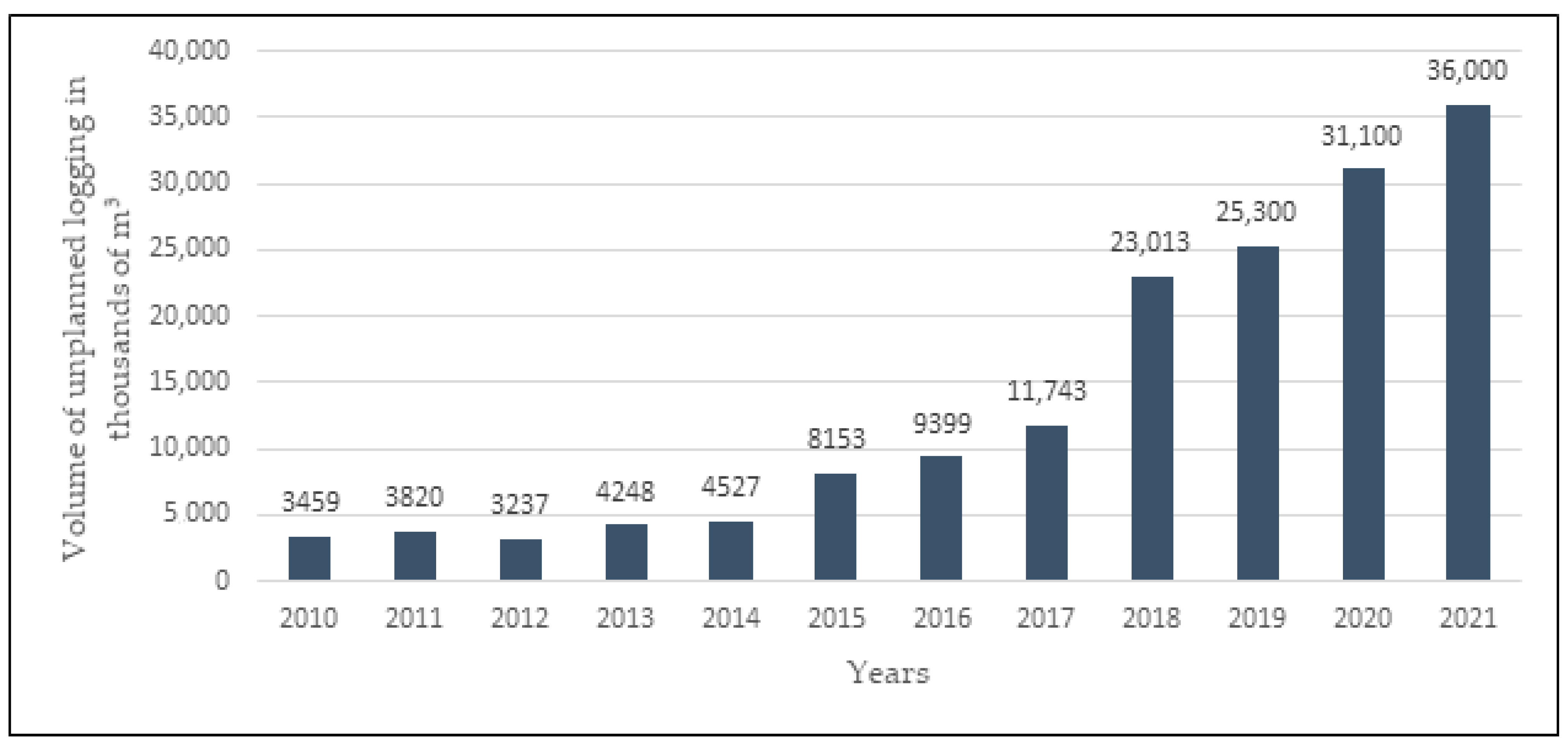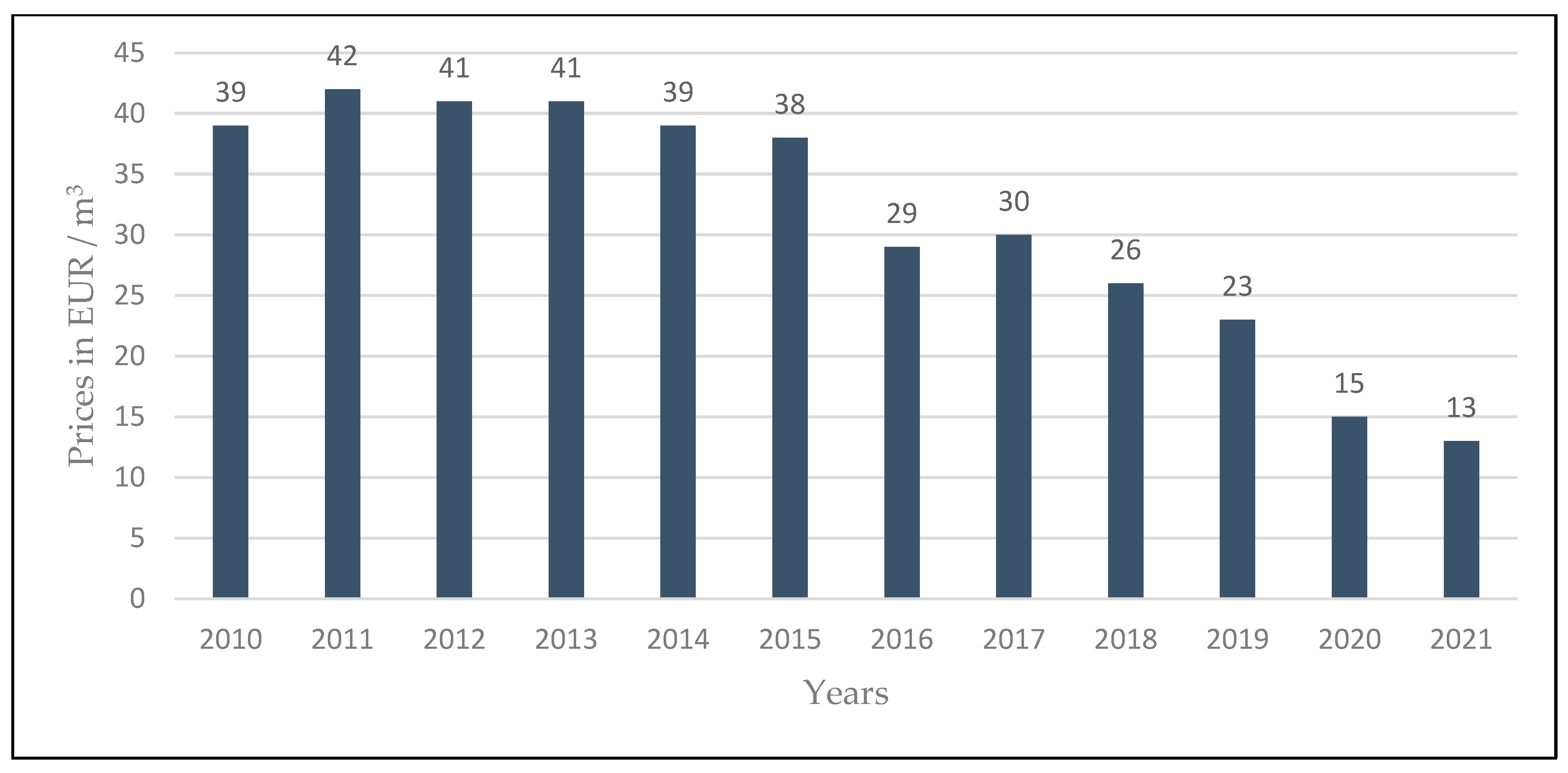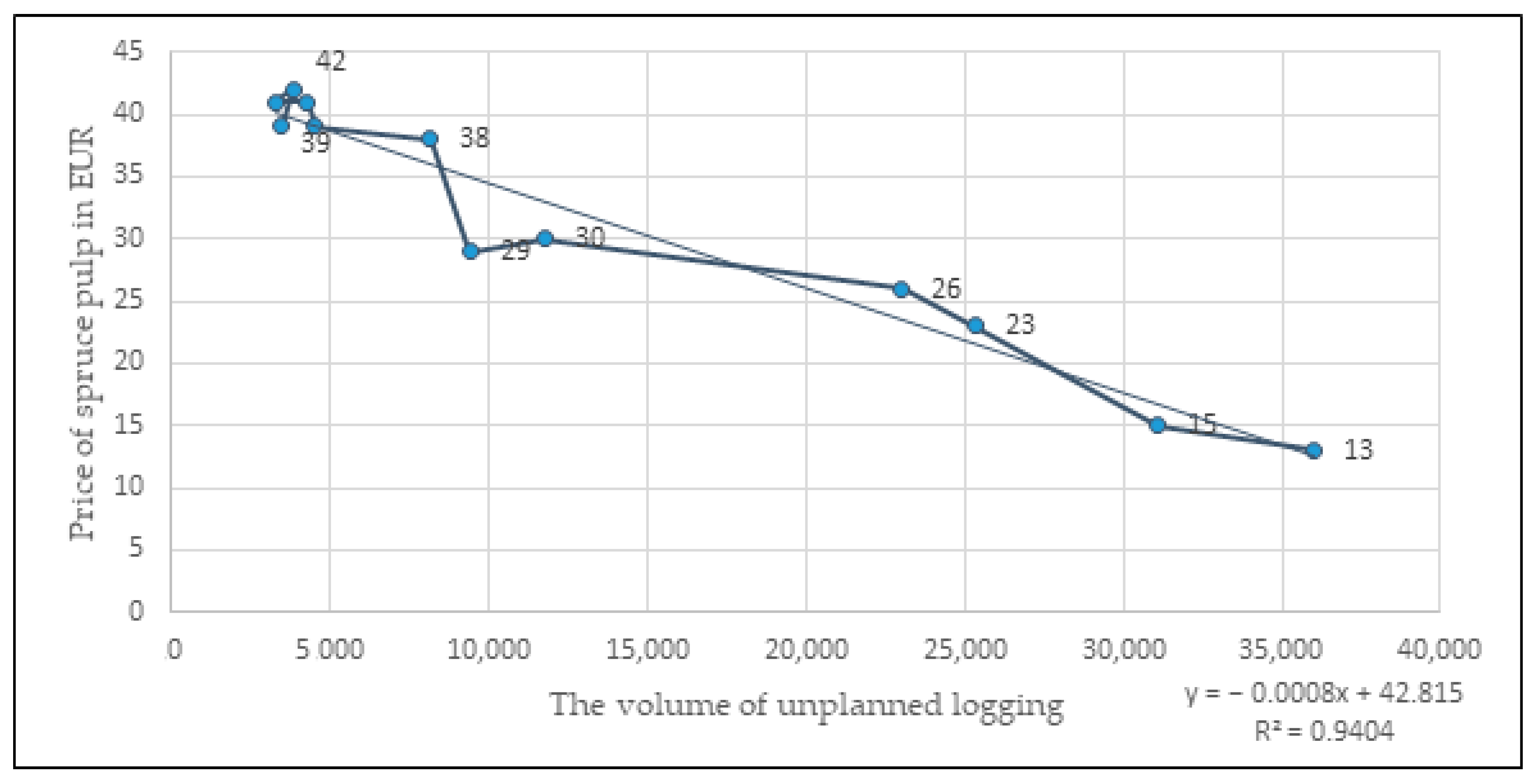The Impacts of Calamity Logging on the Sustainable Development of Spruce Fuel Biomass Prices and Spruce Pulp Prices in the Czech Republic
Abstract
:1. Introduction
2. Materials and Methods
3. Results
4. Discussion
5. Conclusions and Recommendation
Author Contributions
Funding
Acknowledgments
Conflicts of Interest
References
- European Commission. A Sustainable Bioeconomy for Europe: Strengthening the Connection between Economy, Society and the Environment. In Updated Bioeconomy Strategy; European Commission: Brussels, Belgium, 2018; p. 4. ISBN 978-92-79-94144-3. [Google Scholar]
- Winkel, G. Introduction. In Towards a Sustainable European Forest-Based Bioeconomy. Assessment and the Way forward; Winkel, G., Ed.; European Forest Insitute: Joensuu, Finland, 2017; pp. 15–18. ISBN 978-952-5980-42-4. [Google Scholar]
- Toth, D.; Maitah, M.; Maitah, K.; Jarolínová, V. The Impacts of Calamity Logging on the Development of Spruce Wood Prices in Czech Forestry. Forests 2020, 11, 283. [Google Scholar] [CrossRef] [Green Version]
- Eggers, J.; Melin, Y.; Lundström, J.; Bergström, D.; Öhman, K. Management Strategies for Wood Fuel Harvesting—Trade-Offs with Biodiversity and Forest Ecosystem Services. Sustainability 2020, 12, 4089. [Google Scholar] [CrossRef]
- ČSÚ 2019, Forestry—Lesnictví. Available online: https://www.czso.cz/csu/czso/indexy-cen-v-lesnictvi-surove-drivi-3-ctvrtleti-2019 (accessed on 1 January 2020).
- Toth, D.; Maitah, M.; Maitah, K. Development and Forecast of Employment in Forestry in the Czech Republic. Sustainability 2019, 11, 6901. [Google Scholar] [CrossRef] [Green Version]
- Huang, Q.; Zhang, F.; Zhang, Q.; Ou, H.; Jin, Y. Quantitative Assessment of the Impact of Human Activities on Terrestrial Net Primary Productivity in the Yangtze River Delta. Sustainability 2020, 12, 1697. [Google Scholar] [CrossRef] [Green Version]
- McEwan, A.; Marchi, E.; Spinelli, R.; Brink, M. Past, present and future of industrial plantation forestry and implication on future timber harvesting technology. J. For. Res. 2020, 31, 339–351. [Google Scholar] [CrossRef] [Green Version]
- Ministry of Agriculture of the Czech Republic. National Forest Program for the Period until 2013; Ministry of Agriculture of the Czech Republic: Praha, Czech Republic, 2008; p. 7. ISBN 978-80-7084-758-9. [Google Scholar]
- Czech Statistical Office. Population Statistics Department. Available online: https://www.czso.cz/csu/czso/kde-a-jak-bydli-ceske-domacnosti-p2eqbgktkl (accessed on 11 November 2019).
- Czech Statistical Office. Population Statistics Department. Educational Level of Population According to Census Results. Available online: https://www.czso.cz/documents/10180/20536250/17023214.pdf/7545a15a-8565-458b-b4e3-e8bf43255b12?version=1.1 (accessed on 9 December 2020).
- Czech Statistical Office. Press Release—Building Construction Has Been Successful in Recent Years. Available online: https://www.czso.cz/csu/czso/stavebnictvi-se-v-poslednich-letech-dari (accessed on 12 December 2019).
- Czech Statistical Office. Manufacture of Selected Products from Industry—2018 (Výroba Vybraných Výrobků v Průmyslu—2018). Available online: https://www.czso.cz/csu/czso/vyroba-vybranych-vyrobku-v-prumyslu-2018 (accessed on 12 December 2020).
- De Arano, I.M.; Muys, B.; Topi, C.; Petenella, D.; Feliciano, D.M.S.; Rigolot, E.; Lefevre, F.; Prokofieva, I.; Labidi, J.; Carnus, J.M.; et al. A Forest-Based Circular Bioeconomy for Southern Europe: Visions, Opportunities and Challenges. In Reflections on the Bioeconomy; European Forest Institute: Joensuu, Finland, 2018; pp. 1–119. [Google Scholar]
- Zhang, F.; Zhang, Z.; Kong, R.; Chang, J.; Tian, J.; Zhu, B.; Jiang, S.; Chen, X.; Xu, C.-Y. Changes in Forest Net Primary Productivity in the Yangtze River Basin and Its Relationship with Climate Change and Human Activities. Remote Sens. 2019, 11, 1451. [Google Scholar] [CrossRef] [Green Version]
- Biobased Industries Consortium. Bioeconomy Regions in Europe. 2017. Available online: https://biconsortium.eu/sites/biconsortium.eu/files/publications/BIC_GA_Brochure_Bioeconomy_regions_in_Europe_Nov_2017.pdf (accessed on 9 January 2020).
- Romallosa, A.R.D.; Kraft, E. Feasibility of Biomass Briquette Production from Municipal Waste Streams by Integrating the Informal Sector in the Philippines. Resources 2017, 6, 12. [Google Scholar] [CrossRef]
- Czech Statistical Office. Fuel and Energy Consumption in Households; 2010–2020. Available online: https://www.czso.cz/csu/czso/struktura-pouzivanych-paliv-a-energii (accessed on 7 January 2021).
- Ivanova, T.; Mendoza Hernández, A.H.; Bradna, J.; Fernández Cusimamani, E.; García Montoya, J.C.; Armas Espinel, D.A. Assessment of Guava (Psidium Guajava L.) Wood Biomass for Briquettes’ Production. Forests 2018, 9, 613. [Google Scholar] [CrossRef] [Green Version]
- Šodková, M.; Purwestri, R.C.; Riedl, M.; Jarský, V.; Hájek, M. What Drives the Forest Visit? Results of a National Survey in Czech Republic; Czech University of Life Sciences: Prague, Czech Republic, 2020. [Google Scholar]
- Eurostat-European Commission. Forestry Statistics in Detail. Statistics Explained. Available online: https://ec.europa.eu/eurostat/statistics-explained/pdfscache/29576.pdf (accessed on 10 May 2019).
- Eurostat-European Commission. Agriculture, Fishery and Forestry statistics, Main results—2010-11. 2012. Available online: https://ec.europa.eu/eurostat/documents/3930297/5967972/KS-FK-12-001-EN.PDF/0de35d0b-aad0-4cfa-9319-c30f05d46ace (accessed on 10 January 2020).
- Granger, C.W.J.; Newbold, P. Spurious regressions in econometrics. J. Econom. 1974, 2, 111–120. [Google Scholar] [CrossRef] [Green Version]
- Chudý, M.; Reschenhofer, E. Macroeconomic Forecasting with Factor-Augmented Adjusted Band Regression. Econometrics 2019, 7, 46. [Google Scholar] [CrossRef] [Green Version]
- Kucharik, C.J.; Roth, J.A.; Nabielski, R.T. Statistical assessment of a paired-site approach for verification of carbon and nitrogen sequestration on Wisconsin Conservation Reserve Program land. J. Soil Water Conserv. 2003, 58, 58–67. Available online: https://www.jswconline.org/content/58/1/58.short (accessed on 12 December 2019).
- Zarnani, A.; Karimi, S.; Musilek, P. Quantile Regression and Clustering Models of Prediction Intervals for Weather Forecasts: A Comparative Study. Forecasting 2019, 1, 169–188. [Google Scholar] [CrossRef] [Green Version]
- Czech Statistical Office. Fuel and Energy Consumption in Households. Department of Industry, Construction and Energy Statistics (Spotřeba Paliv a Energií v Domácnostech). Available online: https://www.czso.cz/documents/10180/50619982/ENERGO_2015.pdf/86331734-a917-438a-b3c2-43a5414083fc?version=1.4 (accessed on 12 December 2020).
- Nowak, D.; Noble, M.H.; Sisinni, S.M.; Dwyer, J.F. People and Trees: Assessing the US Urban Forest Resource. J. For. Res. 2001, 99, 37–42. [Google Scholar] [CrossRef]
- Millennium Ecosystem Assessment. Ecosystems and Human Wellbeing: Opportunities and Challenges for Business and Industry; World Resources Institute: Washington, DC, USA, 2005; pp. 3–5. [Google Scholar]
- Yang, H.; Yuan, T.; Zhang, X.; Li, S. A Decade Trend of Total Factor Productivity of Key State-Owned Forestry Enterprises in China. Forests 2016, 7, 97. Available online: https://www.mdpi.com/1999-4907/7/5/97 (accessed on 12 December 2019). [CrossRef]
- Xiang, J.; Zhang, W.; Song, X.; Li, J. Impacts of Precipitation and Temperature on Changes in the Terrestrial Ecosystem Pattern in the Yangtze River Economic Belt, China. Int. J. Environ. Res. Public Health 2019, 16, 4872. [Google Scholar] [CrossRef] [PubMed] [Green Version]
- Marusakova, L.; Sallmannshofer, M.; Kaspar, J.; Schwarz, M.; Tyrvainen, L.; Bauer, N. Human Health and Sustainable Forest Management. In Human Health and Sustainable Forest Management; Marusakova, L., Sallmannshofer, M., Eds.; Forest Europe—Liaison Unit Bratislava: Zvolen, Slovakia, 2019; pp. 58–97. ISBN 978-80-8093-266-4. [Google Scholar]
- Chomik, R.; Piggott, J. Mature-age Labour Force Participation: Trends, Barriers, Incentives, and Future Potential. Available online: http://cepar.edu.au/sites/default/files/Mature-age_labour_force_participation.pdf (accessed on 10 October 2019).
- Bamwesigye, D.; Kupec, P.; Chekuimo, G.; Pavlis, J.; Asamoah, O.; Darkwah, S.A.; Hlaváčková, P. Charcoal and Wood Biomass Utilization in Uganda: The Socioeconomic and Environmental Dynamics and Implications. Sustainability 2020, 12, 8337. [Google Scholar] [CrossRef]
- Krieger, D. Economic Value of Forest Ecosystem Services: A Review; The Wilderness Society: Washington, DC, USA, 2001; pp. 1–31. [Google Scholar]
- Maitah, M.; Toth, D.; Smutka, L.; Maitah, K.; Jarolínová, V. Income Differentiation as a Factor of Unsustainability in Forestry. Sustainability 2020, 12, 4749. [Google Scholar] [CrossRef]
- Gruber, J.; Milligan, K.; Wise, D. Social Security Programs and Retirement Around the World: The Relationship to Youth Employment, Introduction and Summary; NBER Working Papers; National Bureau of Economic Research, Inc., 2009; no. wp. 14647. Available online: https://doi.org/10.3386/w14647 (accessed on 10 December 2020).
- Czech Statistical Office. Sales Indices in Transport, Retail and Services; 2010–2020. Available online: https://www.czso.cz/csu/czso/indexy-trzeb-v-odvetvi-dopravy-maloobchodu-a-sluzeb (accessed on 6 February 2021).
- Glück, P. Social Values in Forestry-Synopsis. Ambio 1987, 16, 158–160. Available online: https://www.jstor.org/stable/4313346?seq=1 (accessed on 3 January 2021).
- Seeland, K.; Kilchling, P.; Hansmann, R. Urban Consumers’ Attitudes Towards Non-Wood Forest Products and Services in Switzerland and an Assessment of Their Market Potential. Small-scale For. 2007, 6, 443–452. [Google Scholar] [CrossRef]
- Karnaouri, A.; Matsakas, L.; Bühler, S.; Muraleedharan, M.N.; Christakopoulos, P.; Rova, U. Tailoring Celluclast® Cocktail’s Performance towards the Production of Prebiotic Cello-Oligosaccharides from Waste Forest Biomass. Catalysts 2019, 9, 897. [Google Scholar] [CrossRef] [Green Version]
- European Commission, Renewable Energy Directive, Directive 2009/28/EC of The European Parliament and of the Council of 23 April 2009 on the Promotion of the Use of Energy from Renewable Sources and Amending and Subsequently Repealing Directives 2001/77/EC and 2003/30/EC. Available online: https://eur-lex.europa.eu/legal-content/EN/TXT/PDF/?uri=CELEX:32009L0028&from=EN (accessed on 10 October 2020).
- Pettenella, D.; Secco, L.; Maso, D. NWFP&S Marketing: Lessons Learned and New Development Paths from Case Studies in Some European Countries. Small-Scale For. 2007, 6, 373–390. [Google Scholar] [CrossRef]
- Šišák, L. Importance of Non-Wood Forest Product Collection and Use for Inhabitants in the Czech Republic. J. For. Sci. 2006, 52, 417–426. Available online: https://www.agriculturejournals.cz/publicFiles/55128.pdf (accessed on 12 December 2019). [CrossRef] [Green Version]
- Mansuy, N.; Staley, D.; Taheriazad, L. Mobilization of biomass for bioenergy in a limited landscape: A case study from the First Nations of Cold Lake in Alberta, Canada. Energies 2020, 13, 6289. [Google Scholar] [CrossRef]
- Hope, E.; Gagnon, B.; Avdić, V. Assessment of the Impact of Climate Change Policies on the Market for Forest Industrial Residues. Sustainability 2020, 12, 1787. [Google Scholar] [CrossRef] [Green Version]
- Bryś, A.; Kaleta, A.; Górnicki, K.; Głowacki, S.; Tulej, W.; Bryś, J.; Wichowski, P. Some aspects of modeling of thin-film drying of sawdust. Energies 2021, 14, 726. [Google Scholar] [CrossRef]
- Fischer, A.; Sandström, C.; Delibes-Mateos, M.; Arroyo, B.; Tadie, D.; Randall, D.; Hailu, F.; Lowassa, A.; Msuha, M.; Kereži, V.; et al. On the Multifunctionality of Hunting—An Institutional Analysis of Eight Cases from Europe and Africa. J. Environ. Plan. Manag. 2013, 56, 531–552. [Google Scholar] [CrossRef] [Green Version]
- Littke, K.M.; Harrington, T.B.; Holub, S.M.; Littke, W.R.; Harrison, R.B.; Turnblom, E.C. Douglas-Fir Biomass Allocation and Net Nutrient Pools 15–20 Years after Organic Matter Removal and Vegetation Control. Forests 2020, 11, 1022. [Google Scholar] [CrossRef]
- Fu, Y.; Yang, G.; Song, X.; Li, Z.; Xu, X.; Feng, H.; Zhao, C. Improved winter estimation of aboveground biomass wheat using multilevel textures extracted from UAV-based digital images and hyperspectral function analysis. Remote Sens. 2021, 13, 581. [Google Scholar] [CrossRef]
- Chen, A.J.; Xiao, J.D.; Cao, M.L. Research on change of vegetation index and response to climate in Ili River valley based on MODIS data. Pratacult. Sci. 2016, 33, 1502–1508. (in Chinese). [Google Scholar]
- Federal Ministry for Sustainability and Tourism. Austrian Forest Strategy 2020+; Federal Ministry for Sustainability and Tourism: Wien, Austria, 2018; p. 46. [Google Scholar]
- Millennium Ecosystem Assessment. Ecosystems and Human Well-Being: Synthesis; Island Press: Washington, DC, USA, 2005; p. VI. ISBN 1-59726-040-1. [Google Scholar]
- Nijnik, M.; Nijnik, A.; Brown, I. Exploring the Linkages between Multi-Functional Forestry Goals and the Legacy of Spruce Plantations in Scotland. Can. J. For. Res. 2016, 46, 1247–1254. [Google Scholar] [CrossRef] [Green Version]
- Grêt-Regamey, A.; Altwegg, J.; Sirén, E.; van Strien, M.; Weibel, B. Integrating Ecosystem Services into Spatial Planning-A Spatial Decision Support Tool. Landsc. Urban Plan. 2016, 165, 206–219. [Google Scholar] [CrossRef] [Green Version]
- Dembner, S.A.; Perlis, A. Towards a Harmonized Definition of Non-Wood Forest Products. Unasylva 1999. Available online: http://www.fao.org/3/x2450e/x2450e0d.htm#fao%20forestry (accessed on 9 January 2020).
- Federal Ministry for Agriculture, Forestry Environment and Water Management. Forest in Austria; Federal Research Centre for Forests; Natural Hazards and Landscape: Vienna, Austria, 2017; p. 24. ISBN 978-3-902762-73-3. [Google Scholar]
- Callo-Concha, D.; Jaenicke, H.; Schmitt, C.B.; Denich, M. Food and Non-Food Biomass Production, Processing and Use in sub-Saharan Africa: Towards a Regional Bioeconomy. Sustainability 2020, 12, 2013. [Google Scholar] [CrossRef] [Green Version]
- Vittori Antisari, L.; Papp, R.; Vianello, G.; Marinari, S. Effects of Douglas Fir Stand Age on Soil Chemical Properties, Nutrient Dynamics, and Enzyme Activity: A Case Study in Northern Apennines, Italy. Forests 2018, 9, 641. [Google Scholar] [CrossRef] [Green Version]
- Gitau, J.K.; Sundberg, C.; Mendum, R.; Mutune, J.; Njenga, M. Use of Biochar-Producing Gasifier Cookstove Improves Energy Use Efficiency and Indoor Air Quality in Rural Households. Energies 2019, 12, 4285. [Google Scholar] [CrossRef] [Green Version]
- Mota-Panizio, R.; Hermoso-Orzáez, M.J.; Carmo-Calado, L.; Campos, V.A.F.; Silveira, J.L.; Gonçalves, M.M.; Brito, P. Obnova energie tepelným zplyňováním z elektrických kabelů izolace odpadu (WIEC). Appl. Sci. 2020, 10, 8253. [Google Scholar] [CrossRef]
- Kamble, A.D.; Saxena, V.K.; Chavan, P.D.; Mendhe, V.A. Co-gasification of coal and biomass an emerging clean energy technology: Status and prospects of development in Indian context. Int. J. Min. Sci. Technol. 2019, 29, 171–186. [Google Scholar] [CrossRef]
- Winchester, N.; John, M. Reilly. The feasibility, costs, and environmental implications of large-scale biomass energy. Energy Econ. 2015, 51, 188–203. [Google Scholar] [CrossRef] [Green Version]
- Frank, A.B.; Berdahl, J.D.; Hanson, J.D.; Liebig, M.A.; Johnson, H. Biomass and carbon partitioning in switchgrass. Crop Sci. 2004, 44, 1391–1396. Available online: https://books.google.dk/books?hl=en&lr=&id=DBCQDwAAQBAJ&oi=fnd&pg= (accessed on 12 December 2019). [CrossRef] [Green Version]
- Wu, J.; Zhang, J.; Yi, W.; Cai, H.; Li, Y.; Su, Z. A Game-Theoretic Analysis of Incentive Effects for Agribiomass Power Generation Supply Chain in China. Energies 2021, 14, 546. [Google Scholar] [CrossRef]
- Rimar, M.; Kulikova, O.; Kulikov, A.; Fedak, M. Energy Treatment of Solid Municipal Waste in Combination with Biomass by Decentralized Method with the Respect to the Negative Effects on the Environment. Sustainability 2021, 13, 4405. [Google Scholar] [CrossRef]
- Quiñones-Reveles, M.A.; Ruiz-García, V.M.; Ramos-Vargas, S.; Vargas-Larreta, B.; Masera-Cerutti, O.; Ngangyo-Heya, M.; Carrillo-Parra, A. Assessment of Pellets from Three Forest Species: From Raw Material to End Use. Forests 2021, 12, 447. [Google Scholar] [CrossRef]
- Bojanowska, M.; Chmiel, J.; Sozańska, M.; Chmiela, B.; Grudzień, J.; Halska, J. Issues of Corrosion and Degradation under Dusty Deposits of Energy Biomass. Energies 2021, 14, 534. [Google Scholar] [CrossRef]
- González Martínez, M.; Hélias, E.; Ratel, G.; Thiéry, S.; Melkior, T. Torrefaction of Woody and Agricultural Biomass: Influence of the Presence of Water Vapor in the Gaseous Atmosphere. Processes 2021, 9, 30. [Google Scholar] [CrossRef]
- Sgarbossa, A.; Boschiero, M.; Pierobon, F.; Cavalli, R.; Zanetti, M. Comparative Life Cycle Assessment of Bioenergy Production from Different Wood Pellet Supply Chains. Forests 2020, 11, 1127. [Google Scholar] [CrossRef]





| Unplanned Logging 2010–2020 and the Forecast for the Year 2021 | Thousand m3 (Xi) | Prices of Fuel Spruce Wood EUR/m3 (Converted According to the Exchange Rate 26.63 CZK for EUR 1) | Prices of Spruce Pulp in EUR/m3 (Converted at the Current Exchange Rate of CZK 26.63 for EUR 1) |
|---|---|---|---|
| 2010 | 3459 | 35 | 39 |
| 2011 | 3820 | 35 | 42 |
| 2012 | 3237 | 35 | 41 |
| 2013 | 4248 | 33 | 41 |
| 2014 | 4527 | 32 | 39 |
| 2015 | 8153 | 32 | 38 |
| 2016 | 9399 | 31 | 29 |
| 2017 | 11,743 | 30 | 30 |
| 2018 | 23,013 | 29 | 26 |
| 2019 | 25,000 | 23 | 23 |
| 2020 | 31,000 | 22 | 15 |
| 2021 | 36,000 | 21 | 13 |
| Volume of Unplanned Logging (2010–2020) | ||
|---|---|---|
| Scores | Deviation (X − M) | Squared Dev. |
| 3459 | −8140.91 | 66,274,400.83 |
| 3820 | −7779.91 | 60,526,985.46 |
| 3237 | −8362.91 | 69,938,248.46 |
| 4248 | −7351.91 | 54,050,567.28 |
| 4527 | −7072.91 | 50,026,043.01 |
| 8153 | −3446.91 | 11,881,182.28 |
| 9399 | −2200.91 | 4,844,000.83 |
| 11,743 | 143.09 | 20,475.01 |
| 23,013 | 11,413.09 | 130,258,644.10 |
| 25,000 | 13,400.09 | 179,562,436.37 |
| 31,000 | 19,400.09 | 376,363,527.28 |
| M: 11,599.91 | SS: 1,003,746,510.91 | |
| EUR/m3 | Deviation (X − M) | Squared Dev. |
|---|---|---|
| 35 | 5.17 | 26.69 |
| 35 | 5.17 | 26.69 |
| 35 | 5.17 | 26.69 |
| 33 | 3.17 | 10.03 |
| 32 | 2.17 | 4.69 |
| 32 | 2.17 | 4.69 |
| 31 | 1.17 | 1.36 |
| 30 | 0.17 | 0.03 |
| 29 | −0.83 | 0.69 |
| 23 | −6.83 | 46.69 |
| 22 | −7.83 | 61.36 |
| 21 | −8.83 | 78.03 |
| M: 29.83 EUR/m3 | SS: 287.67 |
| EUR/m3 | Deviation (X − M) | Squared Dev. |
|---|---|---|
| 39 | 7.67 | 58.78 |
| 42 | 10.67 | 113.78 |
| 41 | 9.67 | 93.44 |
| 41 | 9.67 | 93.44 |
| 39 | 7.67 | 58.78 |
| 38 | 6.67 | 44.44 |
| 29 | −2.33 | 5.44 |
| 30 | −1.33 | 1.78 |
| 26 | −5.33 | 28.44 |
| 23 | −8.33 | 69.44 |
| 15 | −16.33 | 266.78 |
| 13 | −18.33 | 336.11 |
| M: 31.33 EUR/m3 | SS: 1170.6 |
Publisher’s Note: MDPI stays neutral with regard to jurisdictional claims in published maps and institutional affiliations. |
© 2022 by the authors. Licensee MDPI, Basel, Switzerland. This article is an open access article distributed under the terms and conditions of the Creative Commons Attribution (CC BY) license (https://creativecommons.org/licenses/by/4.0/).
Share and Cite
Maitah, M.; Toth, D.; Malec, K.; Appiah-Kubi, S.N.K.; Maitah, K.; Pańka, D.; Prus, P.; Janků, J.; Romanowski, R. The Impacts of Calamity Logging on the Sustainable Development of Spruce Fuel Biomass Prices and Spruce Pulp Prices in the Czech Republic. Forests 2022, 13, 97. https://doi.org/10.3390/f13010097
Maitah M, Toth D, Malec K, Appiah-Kubi SNK, Maitah K, Pańka D, Prus P, Janků J, Romanowski R. The Impacts of Calamity Logging on the Sustainable Development of Spruce Fuel Biomass Prices and Spruce Pulp Prices in the Czech Republic. Forests. 2022; 13(1):97. https://doi.org/10.3390/f13010097
Chicago/Turabian StyleMaitah, Mansoor, Daniel Toth, Karel Malec, Seth Nana Kwame Appiah-Kubi, Kamil Maitah, Dariusz Pańka, Piotr Prus, Jaroslav Janků, and Robert Romanowski. 2022. "The Impacts of Calamity Logging on the Sustainable Development of Spruce Fuel Biomass Prices and Spruce Pulp Prices in the Czech Republic" Forests 13, no. 1: 97. https://doi.org/10.3390/f13010097









